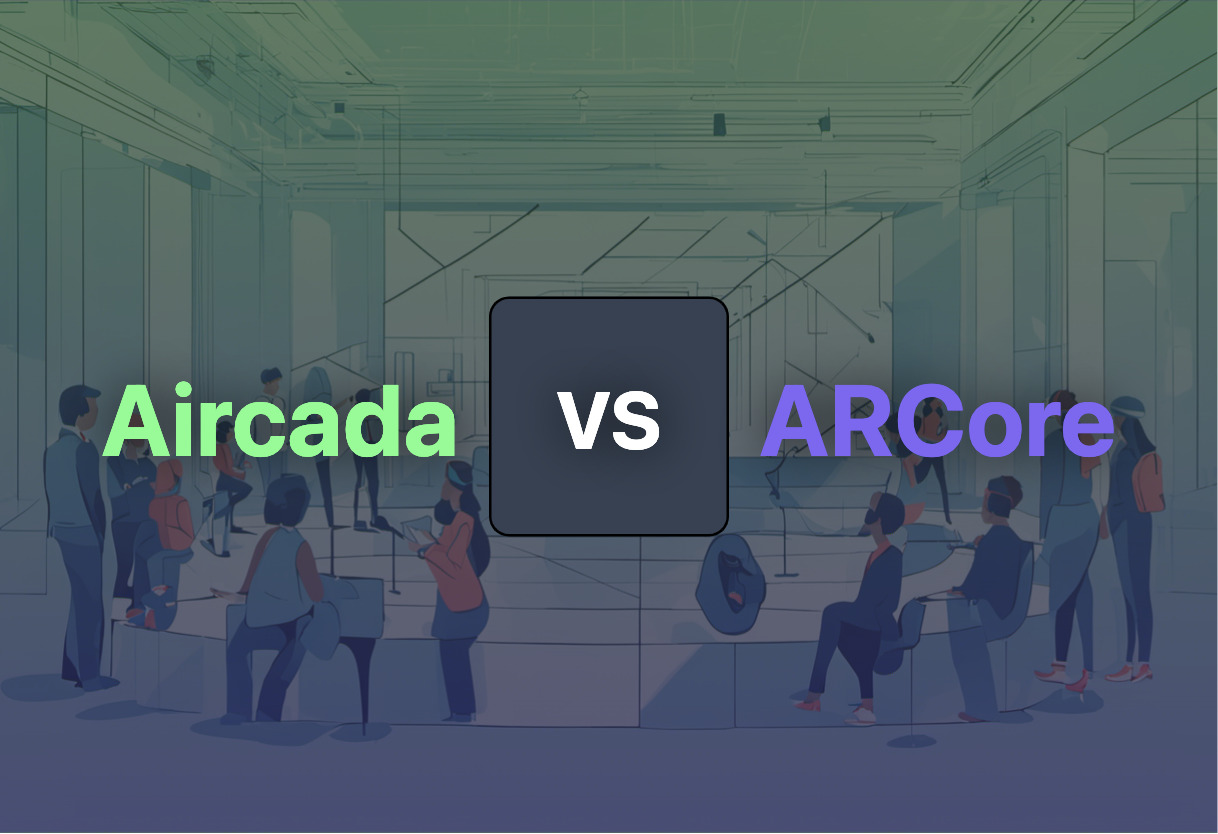For professional and robust AR experiences, Google’s ARCore is a go-to solution, backed by comprehensive APIs and widespread Android ecosystem support. However, if quick, intuitive AR content creation and deployment are prioritized, Aircada emerges as a compelling, economical choice, well-suited for businesses, artists, and AR enthusiasts.

Key Differences Between Aircada and ARCore
- Coding: Aircada is a no-code platform, fostering rapid AR content creation, whereas ARCore requires coding knowledge.
- User Interface: Aircada offers a drag-and-drop action-based system and customizable scenes, while ARCore leverages multiple APIs for interactive experiences.
- Price: Aircada provides competitive plans, including a free tier allowing unlimited projects. Pricing for ARCore isn’t explicitly stated.
- AI Utilization: Aircada employs cutting-edge Spatial AI. ARCore uses AI in Scene Semantics API to label outdoor scenes.
- Platform Accessibility: Aircada is device agnostic, supporting VR/AR headsets and web platforms. ARCore is primarily designed for Android phones with limited iOS support.
- Collaboration: Aircada allows team collaboration, while ARCore doesn’t specify collaborative capabilities.
- Support: Aircada is known for competitive support. User reviews suggest some issues with ARCore’s Google Maps live view compatibility.
| Comparison | Aircada | ARCore |
|---|---|---|
| Platform | No-code platform for AR content | Built by Google for AR experiences |
| Design Suitability | Businesses, AR enthusiasts, marketers, artists, 3D designers, OEMs | Developers of AR experiences or apps |
| Specialization | AR web applications | AR experiences on Android and select iOS devices |
| 3D Capabilities | 3D model scanning & uploading, realistic 3D rendering | 3D mesh using Streetscape Geometry API |
| AI Use | AI-driven algorithms for AR creation | Scene Semantics API uses AI to label every pixel in an outdoor scene |
| Compatibility | Mobiles, tablets, lidar-equipped gadgets | Android 7.0 and later, select iOS devices |
| Security | Encrypted communication | -NA- |
| Multilingual | Supports multiple languages | -NA- |
| Pricing | Freemium model, starts from $20/mo | -NA- |
| Key Features | 3D object scanning, customizable scenes, 2D interface creation, embeddable QR codes and scenes | Motion tracking, environmental understanding, light estimation, geospatial capability |
What Is Aircada and Who’s It For?
Aircada, a no-code platform launched in 2020, specializes in AR content creation, deployment. Suited for businesses of all sizes, AR enthusiasts, 3D designers, marketers, and even industrial OEMs. It barrels through cutting-edge AI-driven algorithms for swift creation.
Aircada is a game-changer for anyone looking to digitize reality with their mobile, tablet or lidar-equipped gadget. Well positioned to capture a significant portion of the AR software market, it promises security and supports team collaboration. Considered the “Canva” of AR content creation, Aircada is a force to reckon with.

Pros of Aircada
- Easy 3D model scanning and uploading
- AI-driven swiftness in AR creation
- Compatible with various devices
- Secure and supports team collaboration
- Regularly updated with new features
Cons of Aircada
- Pricing could be a barrier for small businesses
- Intensive documentation may intimidate less tech-savvy users
What Is ARCore and Who’s It For?
ARCore, developed by Google, is a cutting-edge tool for building Augmented Reality (AR) experiences. Designed to work across Android and iOS devices, ARCore is the ideal platform for anyone intending to create shared AR experiences.
The significant technologies that ARCore inherited from Tango, and the collaborations with manufacturers like Samsung and Huawei, make it an AR powerhouse capable of delivering AR experiences to 1.4 billion Android devices and select iOS devices.

Pros of ARCore
- Offers several APIs for creating realistic AR experiences
- Compatible with a wide array of Android and iOS devices
- Continuously updated for enhanced user experience
Cons of ARCore
- Not compatible with devices running Android versions older than 7.0
- Has been reported to present compatibility issues with Google Maps live view
- Potential unauthorized installing of Google Apps
Aircada vs ARCore: Pricing
Aircada offers highly competitive pricing with a robust free version, while ARCore’s cost information isn’t explicitly available.
Aircada
Pricing for Aircada includes a free edition with extensive features, such as custom branding and unlimited projects. Further plans start at approximately $20 per month, with an enterprise plan available for around $79+ per month.
ARCore
ARCore, developed by Google, doesn’t present explicit pricing information. As a Google service, it is anticipated to be either included in other Google services or funded through Google’s ad-based ecosystem.
The Final Take: Aircada vs. ARCore
Two powerhouse AR technologies, each staking their claim, but which is the standout choice? – That depends on your unique needs.
Tech Enthusiasts
For those seeking an intuitive, no-code AR platform, Aircada offers an impactful user experience. Its swift AR creation, 3D model scanning, automatic visual creation, and seamless device compatibility foster creativity, minus the tech hurdles.

AR/VR Creators
For AR/VR pros aiming for split-second precision and deep-dive data manipulation, ARCore provides robust APIs, accurate motion tracking, and comprehensive environmental understanding. Plus, the introduction of APIs like the ‘Streetscape Geometry’ & ‘Geospatial Depth’ accelerates realism in the AR experience.

Industrial Users
When it comes to industrial training and guided procedures, Aircada shines. With capabilities like encrypted communication, comprehensive team collaboration, and a device-agnostic operation, it becomes a powerhouse for live operational training.

Game Makers
Combining Google’s might with powerful depth measurements and scene semantics, ARCore broadens the horizon for game makers. Existing app enhancement possibilities, accurate AR anchoring, and the provision to scale across the Android ecosystem helps craft next-gen gaming experiences.

In the comparison of Aircada vs ARCore, ARCore excels in building technologically advanced AR experiences, leveraging Google’s wealth of APIs. Aircada stands out for its user-friendly, ultra-rapid AR creation and deployment, particularly appealing to the no-code community, making it the “Canva” of AR creation.
Logan Bellbrook
Content writer @ Aircada with a knack for nature & AR/VR/XR. Blogging the intersection of tech & terrain.





